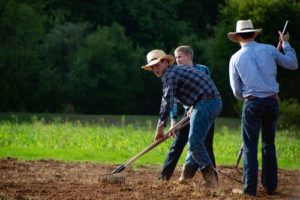Updated July 11, 2020
The Paycheck Protection Program is a great safe benefit to employers but there have been huge conflicts on eligibility for PPP loans for farmers using labor contractors. In fact, many, if not most, have labor contractors instead of traditional employees. Immediately after the CARES Act passed, there was a lot of lobbying around  including businesses that have employees but whom are indirect employees. This primarily affects farmers and their farm labor contractors but also real estate owners who hire property management companies.
including businesses that have employees but whom are indirect employees. This primarily affects farmers and their farm labor contractors but also real estate owners who hire property management companies.
They ultimately provided guidance confirming that businesses using Professional Employer Organizations (PEOs) clearly qualify. It also expanded it to “other similar payroll providers” and gave specific instructions on how to deal with that. We initially had push-back from some banks because they didn’t understand these applications. When submitting a PPP application, employers were required to prove the base of borrowing by including copies of IRS forms showing the employee detail. If you hire a labor contractor, you don’t have that.
The easiest situation to prove is the use of captive labor contractors where the employees only work for your farm–find this information on your contractor’s on the schedule R on form 941. This form documents the nuance between PEOs and independent contractors. Farmers using PEOs assume more responsibility for these employees (it’s considered “leasing”) and is sufficient for PPP loan application documentation. Unfortunately, it’s rare to find a situation where the labor contractor is a PEO.
We eventually got the banks to accept applications for all our farmers who had labor contractors however, a couple of banks never did accept it and so we went to another bank. The rules were very, very process-oriented, and different banks had different rules.
One other important note for farmers’ PPP loans beyond the labor contractors is that they can also qualify as self-employed. Meaning, the profit reported on the tax return can also be included in the application and that loan is attributable to your net profit.
Are the labor contractors passing on the benefit of PPP money to the farmer?
First and foremost, the farmer and the labor contractor can’t both apply for the same employee’s wages and the labor contractor can indeed apply for themselves. But consider this situation: the contractor’s PPP application is approved for $100k as a loan, but then it’s forgiven. Then, they still invoice and get paid from the farmer. They have now been paid twice while the pandemic impacts the farmer negatively multiple ways: the shortage of labor, increased costs to create a safe working environment and the consequences of the current economy reducing profits. Quite a double-dipping and the benefit ends up in the wrong place.
Prior to the guidance that the farmer could receive funds for indirect employees, we began recommending and proposing that the labor contractor obtain the loan and then give a credit to the farmer. Contractors not billing them for the work that the employees were doing there gets the benefit to the person who really incurred the loss. Obviously, there’s some interaction there that may be problematic if you don’t have clear communication and cooperation.
How do we know of which farm labor contractors receive these amounts?
The SBA released the list of recipients on July 6, 2020. You can find out whether your labor contractor has received a loan here: List of PPP Loan Recipients. In addition to the recipients, stats around PPP money are also available. See this link by the Journal of Accountancy for a good summary of key data points.
Isn’t there an obligation to have some sort of loss in order to get the loan forgiven?
If the labor contractor gets the funds but the farmer is still using him as a labor contractor, do they even qualify? The mechanics are twofold. Part one is regarding the application period, in which there must be reasonable “uncertainty” regarding future revenue or losses in order to borrow the money. Politicians began accusing borrowers of criminal activity during this time saying some applicants didn’t “need the money”. Accumulating proof and evidence at this stage was and continues to be important. Part two is forgiveness and it’s much clearer. It’s mechanical in that you must prove that the loan was spent on authorized items: payroll, interest, rent, utilities, et cetera.
The question with the labor contractor situation is that when the labor contractor borrowed the money or submitted his application, was it reasonable for him to expect that he was going to incur a loss? It’s a value judgment and will be hard to prove but that’s the issue. I anticipate we’ll see labor contractors who received the loan but then didn’t realize any impediment to profitability because the farmers continued to pay. In that scenario, the contractor has a problem with having asked for the loan in the first place even though the criteria were met mechanically. When they audit all loans over 2 million, that’s something they’re going to look at very closely.
How do farmers document “uncertainty” as an essential business?
For all clients with loans over $2M we are diligently documenting the point in time in which the loan was taken out in order to have the accountability and proof of significant uncertainty. For example, if you’re an almond farmer, uncertainty can be clearly proven with reports and articles of reduced demand from and exports to India and China. In other cases, we establish uncertainty around bringing in the crop and the labor required there. The fact is there were significant economic losses because of the price, labor, and the inability to ship. Without a doubt, each farmer has experienced a negative impact and they can prove it.
 By: Robert Wiebe
By: Robert Wiebe







